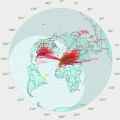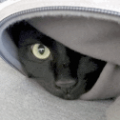jks
About
- Username
- jks
- Joined
- Visits
- 36,254
- Last Active
- Roles
- Member, Administrator, Moderator
- Points
- 639
Reactions
-
new ADC overflow logic (S-meter "OV" indicator) [added in v1.315, improved in v1.357,358]
The latest release adds some averaging to the overflow signal provided by the ADC. This means the "OV" indicator on the S-meter should now reflect a more meaningful indication of an ADC overload condition.
Previously whenever even a single ADC sample (at 66 MHz) was asserting the overflow signal a latch was set and OV was displayed until the next S-meter update cleared the latch. This logic was simple to implement but for a real signal environment it represented an overly pessimistic reaction. The random instantaneous peaks of strong signals could be adding at the ADC input to cause a single sample to overflow occasionally even though most of the time the vast majority of input samples were within the dynamic range of the ADC input.
Now in the FPGA logic there are two counters. One that counts a for a fixed number of sequential samples (64k at the moment) and one that counts only when ADC overflow is being asserted for a sample. At the end of the 64k period the second counter is checked to see if it is greater than 16k. If so then the OV indication is set. So if more than 25% of the samples are overflowed during the period then the ADC is assumed to be overloaded. Note that it doesn't have to be 16k sequential overflowed samples. Just 16k somewhere out of the entire 64k period. All these values are easily changed.
I ran some tests using an hp8657 signal generator @ 10 MHz. At -13 dBm (S9+60) the OV indicator is never lit. At -12 dBm, just 1 dB more, OV begins to appear. More interestingly IMD products begin appearing in the waterfall which validates that the ADC is indeed in an overloaded condition. When using the old logic OV appears beginning at -14 dBm when there is no IMD in the waterfall. So this seems to confirm that the averaging is doing a better job at representing the true ADC condition. This of course is a single-tone measurement and not the real world.
Note: in the image below the S-meter says -11 dBm when the generator is at -12 because the S-meter calibration (admin page, config tab) needs to be adjusted by 1 dB for this particular measurement setup.
-
Audio stop/start button for users, effectively a self-kick button?
-
Channel Button
Jump up/down to next label (including filtered labels): any "alternate-click" on the page up/down buttons (circled "<", ">" icons). An alternate-click is holding the keys shift, alt (aka option) or control and clicking on the button. Or a middle or right-button mouse click on the button (i.e. not the usual left-button click). Or a trackpad right-button click equivalent. Some of these may not work depending on browser interaction.
Keyboard shortcut is ctrl-shift arrow keys or ctrl-shift-j and -i (see keyboard shortcut help menu, '?' or 'h'). -
W/F and SND Bad Params
I'll have an automatic solution built-in to the Kiwi software after I return.
The little bit of decoding I've done is really inexplicable. I can see the beginnings of what they're trying to do. But it's incomplete and the end result is that absolutely nothing of value is gained. Except for adding a bunch of log messages and causing general annoyance. -
update problem [Debian filesystem was full. Huge log files, reason unknown]
I don't know why or where all the log messages were from. Maybe it won't happen again.
Use ssh/PuTTY to login to the Beagle. "df ." command will tell you if your filesystem is full. "cd /var/log" then "du". End of printout from du will be the largest files. I did a "rm syslog daemon.log" because they were huge. But that isn't enough. You have to "reboot" afterwards or else the space will not be freed. -
update problem [Debian filesystem was full. Huge log files, reason unknown]
It's because I just removed (remotely from the beautiful island of Rarotonga whilst on holiday) 1.8GB of junk from your Kiwi's log files. Your Kiwi's filesystem was full so the update could not proceed. I have no idea why it was in this condition. I started to look at the log file. When I saw the word "Microsoft" I stopped reading. -
update problem [Debian filesystem was full. Huge log files, reason unknown]
It's because I just removed (remotely from the beautiful island of Rarotonga whilst on holiday) 1.8GB of junk from your Kiwi's log files. Your Kiwi's filesystem was full so the update could not proceed. I have no idea why it was in this condition. I started to look at the log file. When I saw the word "Microsoft" I stopped reading. -
Kiwi WebSDR kind of stuck at 1.289 - update found... nothing happens... [apt problems, manual fix]
-
Problems updating dx.json
-
TDoA background maps not loading
Later today (hopefully) we will switch back to our previous map provider and the newer TDoA user interface.
We have decided to purchase a commercial subscription, at considerable cost, from the map provider in the interest of expediency. Like the costs to run the proxy service it will be absorbed by KiwiSDR and not passed along to the customer.






